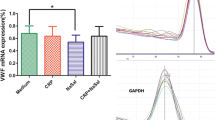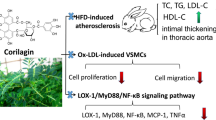Abstract
Objective
The available evidence indicates that C-reactive protein (CRP) participates directly in atherosclerosis formation as an inflammatory molecule. Our previous investigation suggested that fibrinogen, fibrin and fibrinogen degradation products (FDP) produce a pro-inflammatory effect on vascular smooth muscle cells (VSMCs) through inducing CRP generation. In the present study, we observed the effect of pravastatin on CRP generation induced by fibrinogen, fibrin and FDP in rat VSMCs.
Methods
VSMCs from Sprague-Dawley rats were cultured. Fibrinogen, fibrin and FDP were used as stimulants for CRP generation. VSMCs were preincubated with pravastatin at 10, 30, 100 μM for 30 min prior to stimulation. CRP mRNA expression was studied by reverse transcription polymerase chain reaction (RT-PCR). CRP levels in the supernatant of VSMCs were measured by enzyme-linked immunosorbent assay (ELISA). CRP expression in VSMCs was examined with immunocytochemical staining.
Results
ELISA analysis showed that the pravastatin concentration-dependently reduced fibrinogen-, fibrin- and FDP-stimulated generation of CRP in VSMCs, with maximal inhibition of 56.6, 55.7 and 62.3%, respectively. Immunocytochemical staining and RT-PCR revealed that pravastatin inhibited protein and mRNA expression of CRP in VSMCs significantly.
Conclusions
Pravastatin at the concentrations used in the present experiment has ability to relieve vascular inflammation and to restrain atherosclerotic processes via inhibiting the CRP production induced by fibrinogen, fibrin and FDP in VSMCs, which helps explain the beneficial effects of pravastatin on atherosclerosis.










Similar content being viewed by others
References
Hansson GK. Inflammation, atherosclerosis, and coronary artery disease. N Engl J Med. 2005;352:1685–95.
Pasceri V, Willerson JT, Yeh ET. Direct proinflammatory effect of C-reactive protein on human endothelial cells. Circulation. 2000;102:2165–8.
Pasceri V, Cheng JS, Willerson JT, Yeh ET. Modulation of C-reactive protein mediated monocyte chemoattractant protein-1 induction in human endothelial cells by anti-atherosclerosis drugs. Circulation. 2001;103:2531–4.
Wang CH, Li SH, Weisel RD, Fedak PW, Dumont AS, Szmitko P, et al. C-reactive protein upregulates angiotensin type 1 receptors in vascular smooth muscle. Circulation. 2003;107:1783–90.
Espinola-Klein C, Rupprecht HJ, Bickel C, Lackner K, Schnabel R, Munzel T, et al. Inflammation, atherosclerotic burden and cardiovascular prognosis. Atherosclerosis. 2007;195:e126–34.
Koenig W. Fibrin(ogen) in cardiovascular disease: an update. Thromb Haemost. 2003;89:601–9.
Mandl J, Csala M, Léránt I, Banhegyi G, Biró J, Machovich R, et al. Enhancement of interleukin-6 production by fibrinogen degradation product D in human peripheral monocytes and perfused murine liver. Scand J Immunol. 1995;42:175–8.
Perez RL, Roman J. Fibrin enhances the expression of IL-1 beta by human peripheral blood mononuclear cells. Implications in pulmonary inflammation. J Immunol. 1995;154:1879–87.
Guo F, Liu JT, Wang CJ, Liu N, Lu PP. Fibrinogen, fibrin and FDP induce C-reactive protein generation in rat vascular smooth muscle cells: pro-inflammatory effect on atherosclerosis. Biochem Biophys Res Commun. 2009;390:942–6.
Veillard NR, Mach F. Statins: the new aspirin? Cell Mol Life Sci. 2002;59:1771–86.
Gaugler MH, Vereycken-Holler V, Squiban C, Vandamme M, Vozenin-Brotons MC, Benderitter M. Pravastatin limits endothelial activation after irradiation and decreases the resulting inflammatory and thrombotic responses. Radiat Res. 2005;163:479–87.
Hadrava V, Tremblay J, Hamet P. Abnormalities in growth characteristics of aortic smooth muscle cells in spontaneously hypertensive rats. Hypertension. 1989;13:589–97.
Ramsby ML, Kreutzer DL. Fibrin induction of interleukin-8 expression in corneal endothelial cells in vitro. Invest Ophthalmol Vis Sci. 1994;35:3980–90.
Naito M, Stirk CM, Smith EB, Thompson WD. Smooth muscle cell outgrowth stimulated by fibrin degradation products. The potential role of fibrin fragment E in restenosis and atherogenesis. Thromb Res. 2000;98:165–74.
Montecucco M, Mach F. Update on statin-mediated anti-inflammatory activities in atherosclerosis. Semin Immunopathol. 2009;31:127–42.
Li L, Roumeliotis N, Sawamura T, Renier G. C-reactive protein enhances LOX-1 expression in human aortic endothelial cells: relevance of LOX-1 to C-reactive protein-induced endothelial dysfunction. Circ Res. 2004;95:877–83.
Singh U, Dasu MR, Yancey PG, Afify A, Devaraj S, Jialal I. Human C-reactive protein promotes oxidized low density lipoprotein uptake and matrix metalloproteinase-9 release in Wistar rat. J Lipid Res. 2008;49:1015–23.
Jian Y, Tang ZY, Wang YY, Peng SQ. Polyaspartoyl l-arginine protects endothelial cells against injury. Eur J Pharmacol. 2008;599:96–101.
Smith EB, Thompson WD, Crosbie L, Stirk CM. Fibrinogen/fibrin in atherogenesis. Eur J Epidemiol. 1992;8:83–7.
Green D, Foiles N, Chan C, Schreiner PJ, Liu K. Elevated fibrinogen levels and subsequent subclinical atherosclerosis: the CARDIA study. Atherosclerosis. 2009;202:623–31.
Herrick S, Blanc-Brude O, Gray A, Laurent G. Fibrinogen. Int J Biochem Cell Biol. 1999;31:741–6.
Valenzuela R, Shainoff JR, DiBello PM, Urbanic DA, Anderson JM, Matsueda GR, et al. Immunoelectrophoretic and immunohistochemical characterizations of fibrinogen derivatives in atherosclerotic aortic intimas and vascular prosthesis pseudo-intimas. Am J Pathol. 1992;141:861–80.
Khrenov AV, Ananyeva NM, Griffin JH, Saenko EL. Coagulation pathways in atherothrombosis. Trends Cardiovasc Med. 2002;12:317–24.
van der Harst P, Asselbergs FW, Hillege HL, Bakker SJ, Voors AA, van Veldhuisen DJ, et al. Effect of withdrawal of pravastatin therapy on C-reactive protein and low-density lipoprotein cholesterol. Am J Cardiol. 2007;100:1548–51.
Caorsi C, Pineda F, Munoz C. Pravastatin immunomodulates IL-6 and C-reactive protein, but not IL-1 and TNF-alpha, in cardio-pulmonary bypass. Eur Cytokine Netw. 2008;19:99–103.
Acknowledgments
This work was supported by the Doctoral Fund of the Ministry of Education of China (No. 20100201110053).
Author information
Authors and Affiliations
Corresponding author
Additional information
Responsible Editor: Makoto Katori.
Rights and permissions
About this article
Cite this article
Guo, F., Liu, JT., Wang, CJ. et al. Pravastatin inhibits C-reactive protein generation induced by fibrinogen, fibrin and FDP in isolated rat vascular smooth muscle cells. Inflamm. Res. 61, 127–134 (2012). https://doi.org/10.1007/s00011-011-0396-4
Received:
Revised:
Accepted:
Published:
Issue Date:
DOI: https://doi.org/10.1007/s00011-011-0396-4




